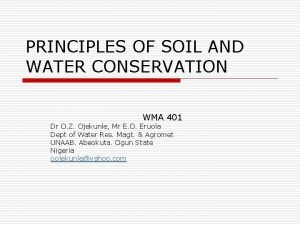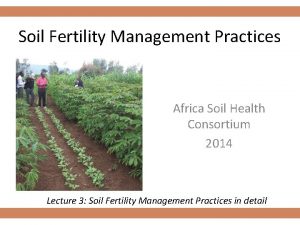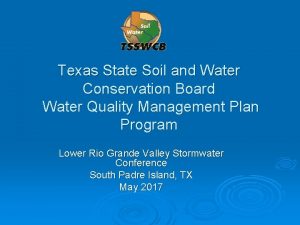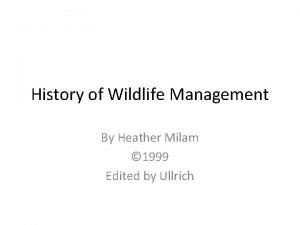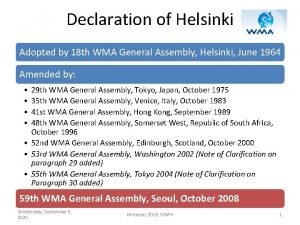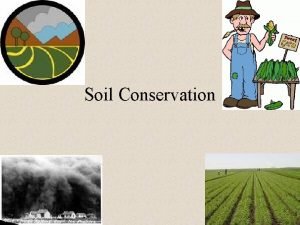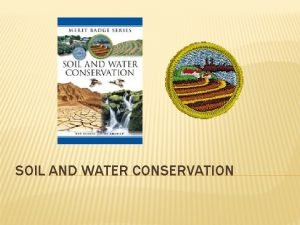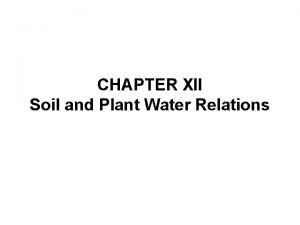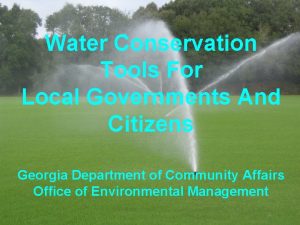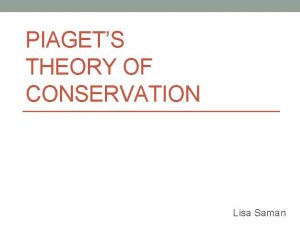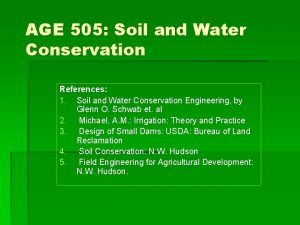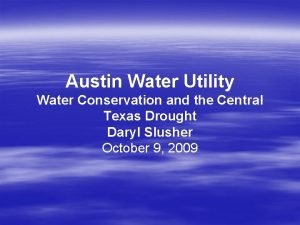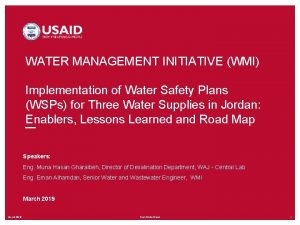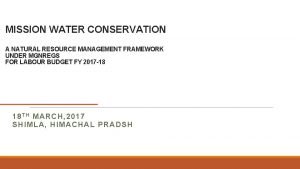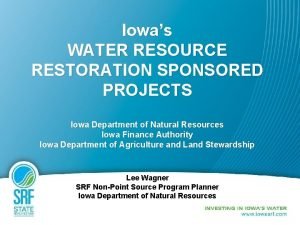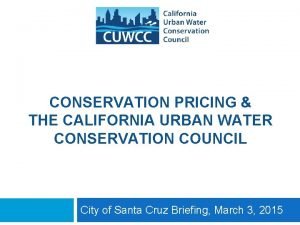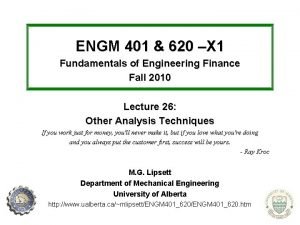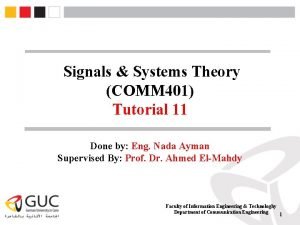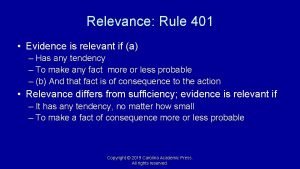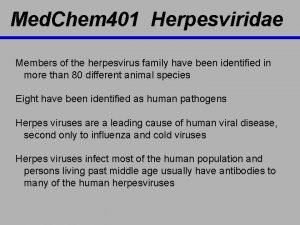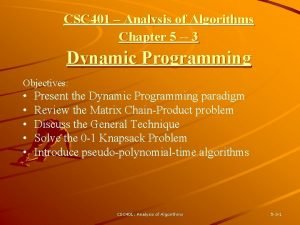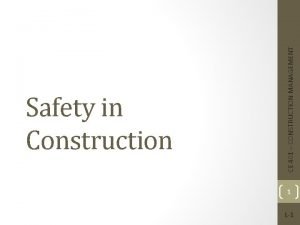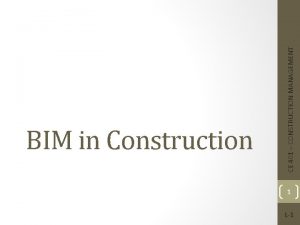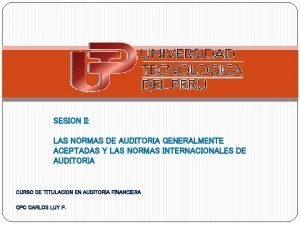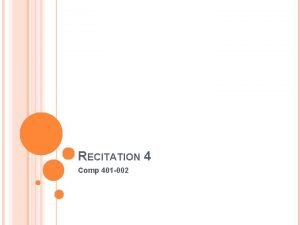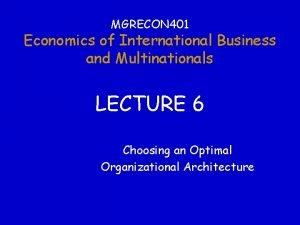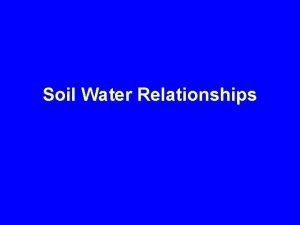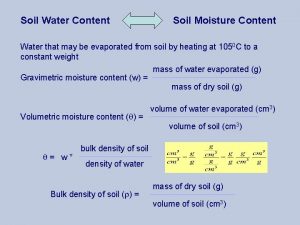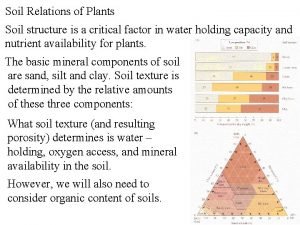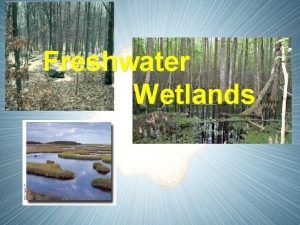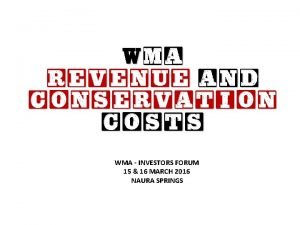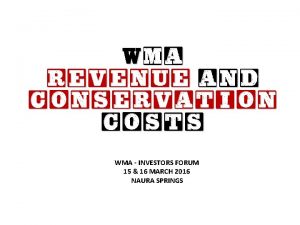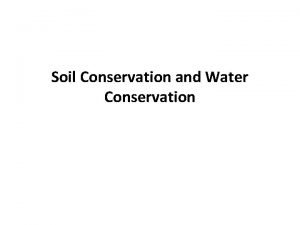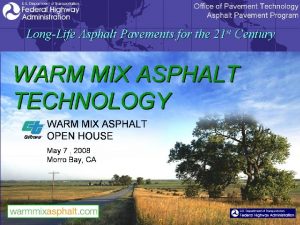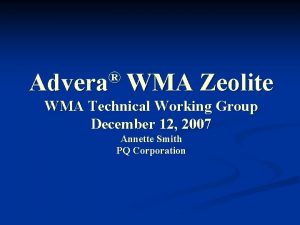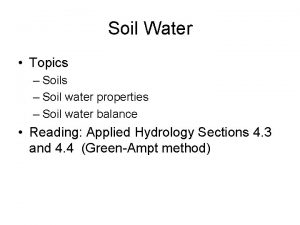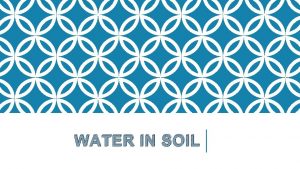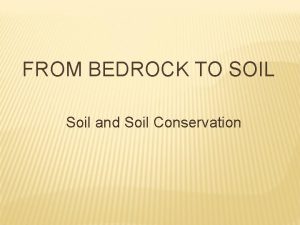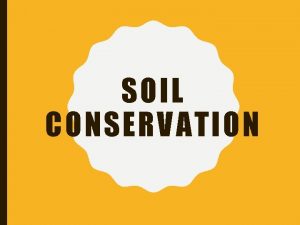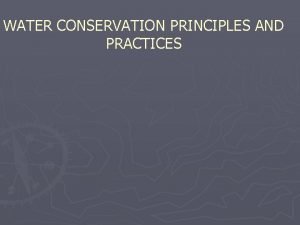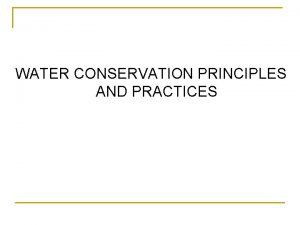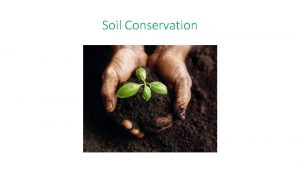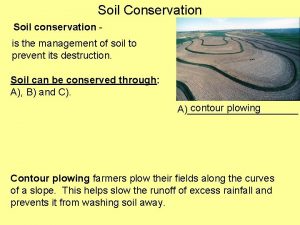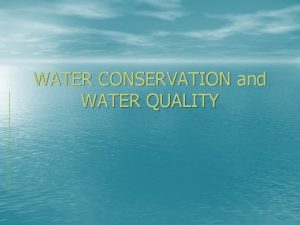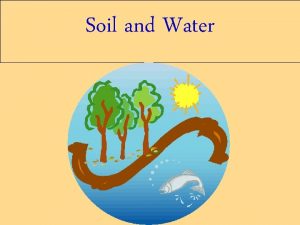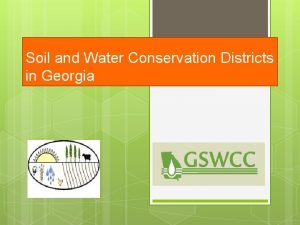PRINCIPLES OF SOIL AND WATER CONSERVATION WMA 401

































































- Slides: 65

PRINCIPLES OF SOIL AND WATER CONSERVATION WMA 401 Dr O. Z. Ojekunle, Mr E. O. Eruola Dept of Water Res. Magt. & Agromet UNAAB. Abeokuta. Ogun State Nigeria oojekunle@yahoo. com

PRINCIPLE OF SOIL AND WATER CONSERVATION WMA 401 IMPORTANT INFORMATION # Decide Convenient Time of Meeting # Course Outline # Term Paper to be submitted 3 weeks b 4 Exams # Attendance very Important # Late Coming not allow # No Phone call or eating during lecture # Contact me when the need arises # Study Well and I wish you the BEST

Scope of Soil and Water Conservation Principles o The Primary purposes of soil and water conservation is to ensure sustainable productivity of land through conservation of water resources and the prevention or reduction of soil erosion, land slides and debris flow. o All soft top soils when exposed to rains or streams are subject to erosion. Washed off soil, when carried away by runoff water will bring polluted material upon downstream and drainage. Therefore in addition to the maintenance of fertility soil conservation should also anticipate those problems.

Soil Conservation Defined o Can be defined as maintaining high productivity with minimum amount of soil lost. In this way useful life is extended by conserving nutrient. o Objectives of Soil Conservation o Promotion of proper landuse o Prevention of Soil erosion and restoration of the fertility of eroded land o Maintenance of soil fertility o Reduction of water runoff and regulation of water resources o Prevention of water and land pollution caused by carried off soil and debris o Enforcement of safe drainage and irrigation on slope land o Prevention of wind erosion.

Methods of Soil Conservation o Agriculture Practices o Crop Management Principles o Affecting Plant rate o Affecting Plant date o Improved Crop Species o Soil Management o o Physical/ Mechanical Process -Terracing (Very Steep Slope) - Contouring -Strip Cropping

Water Conservation Defined o Is the efficient management of water to reduce evaporation or waste and to make water available when and where needed o Objectives of Water Conservation and Management o Improve availability of water for plant use. Plant requires water for carbohydrate metabolism, for heat dissipation, medium of nutrients transportation. o Hydropower generation: Construction of hydraulic structure (Dam) to generate high load of electricity o Irrigation: Provide artificial supply of water for plant when rainfall is insufficient or not available.

Methods of Water Conservation Practices n o o o Water resources development Collection and storage of surface water Recharge of ground water The above can be achieved by building (i) dams, (ii) Water harvest system (iii) Ponds n Flood Control: Canals, Weirs, dams etc. n Moisture Conservation Practices Tillage Operation: Ridge (Improving infiltration and reducing evaporation) Grass Barrier Mulching

Problems of Soil and Water Conservation n Insufficient Data: i. e data related to o -Climate e. g. Rainfall, humidity, windspeed and sunshine records -Soil data - Water Use data: Stage and discharge record measurement. n Government Policy (Bureaucratic bottonneck, empty promises) o Not Conducive research approached o Poor Training Programme o Non Availability of facility and fund n Insufficient awareness and concern n Farmers Literacy level n Problem solving approaches e. g. Familiarization with the farmers and solution to solving problem of conservation n Government involvement needs to improve.

GEOMORPHOLOGICAL FACTORS AFFECTING SOIL AND WATER CONSERVATION o Climate: o Topography: o Soil Characteristics: o Vegetation: o Human Behaviour:

GEOMORPHOLOGICAL FACTORS AFFECTING SOIL AND WATER CONSERVATION (Cont) o Climate: Rainfall, wind (Detactment and transportation effect of water and wind), depend on intensity of rain drops impact, volume and speed of runoff. o Topography: Gradient of Slope, Shape of area o Soil Characteristics: Resistance of soil against detachment and movement which relied on

GEOMORPHOLOGICAL FACTORS AFFECTING SOIL AND WATER CONSERVATION (Cont) o Soil Textureo Soil Structure-

GEOMORPHOLOGICAL FACTORS AFFECTING SOIL AND WATER CONSERVATION (Cont) o Soil Moisture- The degree of soil moisture saturation content will definitely affects erosion. o Vegetation: Covering, Height, density o Human Behaviour: Deforestation, Pollution of canal/channel, bad farm management practices (Excessive utilization of land for farming strips, the gradient of protective cover and destabilization of the top soil, consequently destroying the great fertile land of many years)

SOIL EROSION Defined o Soil erosion is a phenomenon that happens when soil is washed by rain, runoff water or waves, blown by wind or affected by gravity or drastic temperature variation. Under these influences, soil structures disintegrate and the soil particle becomes detached. Eventually the particles will be carried away and deposited at another location. o Causes of Soil Erosion o Soil erosion is mostly caused by water and wind, something both simultaneously or consecutively at the same location. When that happens, their destructive power will be multiple.

Significance of Soil Erosion o Loss of top soil: Causes insufficient growth in plant o Nutrient Loss: same as 1 o Stream pollution: Silting of dam reserviour, water bodies reduce the hydropower pressure head i. e water level in the reserviour.

Forms of Erosion o Normal and Accelerated o Normal Erosion (Natural erosion or geological erosion) This type of erosion takes place when the environmental elements in an area remain undisturbed and the natural vegetative cover unbroken. It goes unceasingly all the time. o Accelerated Erosion: This takes place when vegetative cover or the stability of top soil is broken. In this type of erosion, movement of soil particles becomes extensive and the soil particles are stripped off their structural chemical elements.

Agents and Process of Erosion o Agents of Erosion o -Water o -Wind o -Gravity o Process of Erosion o Detachment: o Transportation: (Suspension, Saltation and Bed Creeps) o Deposition:

Process of Erosion o Detachment: This involves the loosening of particles within the soil aggregate. The usual agent includes rain drops and water flow in phases. o Factors Affecting Detachment n n n Rainfall factors including raindrop size, velocity and amount of rainfall. Soil factors including soil structure and infiltration of the soil. Texture of the soil; the sandy soil will be easily detached compared to clay

Process of Erosion o Transportation: This is the movement of detached soil from one place to another. This can be divided into 3 modes, they are Suspension, Saltation, Bed Creeps. o Agent of Transportation o Runoff o Splash of rain drops

Process of Erosion n Deposition: This refers to the release of sediment load in the runoff to the bottom of the bed when runoff reaches flat lowland the current slows down. o The factor influencing depositions are o o The size of the soil unit Runoff velocity Turbulence in the runoff Obstruction to flow

Factor Affecting Water Erosion o The main factor affecting erosion by water are o Topography, Climate, Soil and Vegetative cover o Topography we have Slope and water shed characteristic o Climate we have rainfall erosivity and other factor that affect soil moisture content and plant growth. o Soil, we have permeability, transportability and detachability o Vegetative cover we have canopy and mulching

Topography o Water Shed: o Size, shape and the length of water shed o Slope:

Climate: o Rainfall erosivity will involve the intensity, duration and the pattern of rainfall. o The factor that will affect moist content and plant growth will include Temperature, humidity and solar radiation.

Soil: o Permeability to water will be affected by porosity and hydrostatic pressure in the pore. o Transportability will be influenced by aggregate size. o Detachability will be influenced by aggregate stability i. e how the aggregate particles are bonded together

Vegetative Cover o Canopy refer to the living plant height and density of vegetation o Mulch refers to death organic material and vegetation that spread on the soil.

FACTOR INFLUENCING EROSION o Erosivity and Erodibility Factors o Erosivity Agent: Refers to ability of agent to cause erosion (i. e. rainfall). This factors responsible for erosivity and cause erosion are o Intensity of rainfall: o Duration of rainfall o - Pattern of rainfall o - Raindrops size, shape o - Frequency of rainfall

- Intensity of rainfall: o Soil loss is closely related to rainfall partly through the detaching power of raindrops striking the soil surface and partly the contribution of rain runoff. The most suitable expression of the erosivity of rainfall is an index base on the kinetic of the rain. Thus the erosivity of a rain is a function ot its intensity and duration, and of the mass, diameter and the velocity of the raindrops. Inspite of the difficulties posed by these variations, it is possible to derive general relationships between kinetic energy and rainfall intensity. Based on the work of Laws and Parsons (1943), Wischmeier and Smith (1985) Obtained the equation o KE = 11. 87+8. 73 log 10 I o Where I is the rainfall intensity (mm/h) and KE is the Kinentic Energy (Jm-2 mm-1)

Wind Erosivity: o Wind Erosivity: The kinetic energy (KEa; Jm-2 mm-1 ) of wind can be calculated from KEa= o KEa =Where u is the wind velocity in m/s and is the specific weight of air defined in terms of temperature (T) in o. C and barometric pressure (P) in k. Pa by the relationship (Zachar) S =

Erodibility Factors o Erodibility Factors: Refers to the ability to be eroded, it can be related to soil as it the soil that is being carried away. The erodibility factors are o - Structure of soil which may include aggregate size, stability o - Moisture content: o - Soil Porosity o - Vegetation Cover in term of canopy and organic matter. (mulch)

SPATIAL AND TEMPORAL MEASUREMENT OF EROSION PROCESSES o The effectiveness of overflow as an eroding agent depends on its spatial extent and distribution over a hillside. Horton (1945) describes overland flow covering two-thirds or more of the hillslopes in a drainage basin during the peak period of a storm. The flow results from the rainfall intensity being greater than the infiltration capacity of the soil and is distributed over the land surface in the following pattern. At the top of a slope is a zone without flow which forms a belt of no erosion. At a critical distance from the crest sufficient water has accumulated on the surface for the flow to begin. Moving further downslopes, the depth of flow increases with a distance from the crest until, at a further critical distance, the flow becomes concentrated into fewer and deeper flow paths which occupy a progressively smaller portion of the hillslope (Parsons, Abraham and Luk 1990).

SPATIAL AND TEMPORAL MEASUREMENT OF EROSION PROCESSES (Cont) o Hydraulic efficiency improves allowing the increased discharge to be accommodated by a higher flow velocity. Nevertheless, the hydraulic characteristics of the flow vary greatly over very short distances because of the influenced of bed roughness associated with vegetation and stones. As a result, erosion is often localized and after a rainstorm the surface of a hillside display a pattern of alternating scours and sediment fans (Moss and Walker 1978). Eventually, the flow breaks up into rills. That overland flows occurs in such a widespread has been question, particularly in well vegetated areas where such flow occurs infrequently and covers only 10 to 30 percent of the area of a drainage basin closest to the stream sources (Kirkby 1969 a).

SPATIAL AND TEMPORAL MEASUREMENT OF EROSION PROCESSES (Cont) o Under these conditions its occurrence is more closely related to the saturation of the soil and the fact that moisture storage capacity is exceeded rather than infiltration capacity. Although, as illustrated by the detailed studies of Dunnes and Black (1970) in a small forested catchment in Vermont, the saturated areas expand contract, being sensitive to heavy rain and snow melt, rarely cab erosion by overland flow affect more than a small part of the hillslopes.

Subsurface flow o The lateral movement of water downslope through the soil is known as interflow. Where it takes place as concentrated flow in tunnels or subsurface pipes its erosive effects through tunnels collapse and the gully formation are well known. Less is known about the eroding ability of water moving through the pore spaces in the soil, although it has been suggested that fine particles may be washed out by this process (Swan 1970). Pilgrim and Huff (1983) measured sediment concentration as high as 1 g/l in subsurface flow through a silt-loam on a 17 o slope under grass in California in storms of 10 mm/h intensity or less. More important than the sediment concentrations, however, are the base mineral concentrations in the subsurface flow. Essential plants nutrients, particularly those added by fertilizers, can be removed, thereby impoverishing the soil and reducing its

Types of Erosion by Water o Interrill Erosion: is made up of splash and sheet erosion o Rainsplash/Splash Erosion: This is also known as raindrop erosion, this take place when a rain drop hits the ground. At the point of impact, the soil structure will be form apart by the kinetic energy released by the rain drop. The detached soil particles will be splash over the surrounding area. If these particles are not transported away by runoff, they will pile up, sometimes attaining a thickness of several centimeters.

Sheet Erosion: o The uniform removal of a thin layer of soil surface by runoff. The rolling power of the sheet is a function of the depth and velocity of flow. When Precipitation slightly exceeds soil permeability, excessive water will form a thin sheet or film of no more than 0. 1 -3. 0 mm thick. Water in this states moves over the gradient surface and between soil particles, sometimes with very small ripples. As its speed of flow increases, especially when the film slides over a slope without resistance, it peels the surface soil off layer by layer. Sheet erosion removes fine particles and organic matter from the soil without leaving any clear traces, although the soil will be deprived of its fertility.

Rill Erosion: o It is widely accepted that rills are initiated at a critical distance downslope where overland flow becomes channeled. The break-up of shallow overland flow into small channels of micro-rills was examined by Moss, Green and Hukta (1982). They found that in addition to the main flow path downslope, secondary flow path developed with a lateral component. Where these converged, increase in discharge intensified particle movement and small channels or trenches were cut by scouring (running water) erode (a channel or pool). o Are channel formed due to concentration of water. At first runoff, there will strong clear pattern, or mark in the ground with numerous wrinkles. The wrinkles will deepen into grooves and then gutters. A rill is always not more than 30 cm in depth and 100 cm in width. A cut beyond this

Gully Erosion o is just an advanced stage of rill erosion while rill can be removed by normal tillage operations, gully erosion cannot be removed. Gully are relatively permanent steep-sided water courses which experience ephemeral flows during rainstorm. Compared with Stable River channels which have a relatively smooth, concave-upwards long profile, gullies are characterized by a headcut and various steps or knick-points along the course. These rapid changes in slope alternate with sections of very gentle gradient, either straight or slightly convex in long profile. Gullies also have relatively greater depth and smaller width than stable channels, carry larger sediment loads and display very erratic behaviour so that relationships between sediment discharge and runoff are frequently poor (Heede 1975).

Gully Erosion (Cont) o Gullies are almost associated with accelerated erosion and therefore with landscape instability. Depending on the texture of the soil and bedrock, as well as the gradient of the slope, gullies are generally cut into one of the following four forms

Gully Erosion (Cont) o Shallow through form: Usually found in places where the soil is heavy and firm. The gully is wide but shallow with obtuse edges. o V Form: Found where thick top soil exits o U Form: Gullies of this type are cut where there is hard bed rock under soft top soil. o Complex Form: This is a combination of U and V form, with a U at the top of the gully and a V at the bottom formation of this type of gully is mainly due to the existence of a hard sub statum “sandwiched” between the top soil and another layer of soil beneath.

Process of Gully Erosion o Upslope movement which occurs at the head of the gully. It is sometimes called water fall erosion. o The second stage is channel erosion which is erosion in channel down slope both from side and bottom from the gully o Mass movement from sides of the soil into the channel

THE RESPONSE OF A SOIL TO A GIVEN RAINFALL (Cont) o Depends upon the moisture content and, therefore the structural state of the soil, and the intensity of the soil. Le. Bissonnais (1990) describes 3 possibilities. o If the soil is dry and the rainfall intensity is high, the soil aggregates break down quickly by slaking. This is the breakdown by compression of air ahead of the wetting front. Infiltration capacity reduces rapidly and on a very smooth surface, runoff can be generated after only a few millimetres of rain. With rougher surfaces, depression storage is greater and the runoff takes longer to form.

THE RESPONSE OF A SOIL TO A GIVEN RAINFALL (Cont) o If the aggregates are initially partially wetted or the rainfall intensity is low, microcracking occurs and the aggregate breaks down into smaller aggregates. Surface roughness thus decrease but infiltration remains high because of a large pores spaces between the mircoaggregates. o If the aggreages are initially saturated, infiltration capacity depends on the saturated hydraulic conductivity of the soil and large quantities of rain are required to seal the surface. Nevertheless, soils with less than 15 percent clay content are vulnerable to sealing if the intensity of the rain is high.

Grazing animals as Erosion Hazard o o o Soil factor Soil Structure Soil Texture Soil Moisture Micro-Climate

EFFECT OF CULTIVATION METHODS AND CROPPING SYSTEM ON EROSIONS o o o CULTIVATION INVOLVES Land cropping Ploughing Harrowing Seedling Weeding

EFFECT OF CULTIVATION METHODS AND CROPPING SYSTEM ON EROSIONS (Cont) o o o Improvement on soil and soil water regime. Runoff management may be classified as Increase water intake and storage and so reduce runoff Control water movement over the soil surface Dispose safely of the excess rainfall as runoff or concentrate on inadequate rainfall runoff.

GUIDELINES FOR PLANNING SOIL CONSERVATION MEASURE (Cont) o Planning of land use according to land capability on the basis of conservation of farm planning o Reducing splash erosion with vegetation which shields the ground surface against the impact of rain o Strengthening soil resistance against erosion with vegetative, agronomic and engineering measure o Reducing run-off, through increase of the absorption capacity of ground, with agronomic , vegetative and engineering measures

GUIDELINES FOR PLANNING SOIL CONSERVATION MEASURE (Cont) o Increasing the roughness of ground surface so as to reduce the speed of run-off by engineering, agronomic and vegetative measure. o Draining run-off with a specially designed drainage system aimed at preventing erosion. Vegetative measure may be incorporated to strengthen the preventive effect o Reinforcing protection of points such as farm paths and drainage channels where erosion and slides are likely to take place, with adequate drainage system

SOIL AND WATER CONSERVATION METHOD o Soil and water conservation in Agriculture can be grouped into 3 o Practices that reduce run-off through improved infiltration capacity and soil transmission characteristics. o Practices that reduce run-off by controlling water movement over the surface. o Practices that permits safe disposal of run-off

PRACTICES THAT REDUCE RUN-OFF THROUGH IMPROVED INFILTERATION CAPACITY AND SOIL TRANSMISSION o o o Mulching Farming Soil Conditioners Cover Crops Alley Cropping Ploughing

PRACTISES THAT REDUCE RUN-OFF BY CONTROLLING WATER MOVEMENT OVER THE SURFACE n n Strip Cropping Contour Farm Ridge and Mound Terrace Farming

PRACTISES THAT PERMITS SAFE DISPOSAL OF RUN-OFF o Where land use management alone is insufficient to prevent runoff, the excess water has to be removed without causing erosion. Undesireable runoff can be intercepted or diverted from an area above cultivated land led away safely by a combination of physical measure including interception, terraces, diversion ditches or storm-water drains, waterway and terraces channel. The interception terrace and diversion ditches are placed up slope of areas where protection is required to intercept runoff on the hillside and channeled across slope at a non-erosive velocity along a near level, gently-graded, terrace channel, to a suitable outlet which may be a natural or artificial waterway.

SOIL AS A NATURAL BODY o The soil is the tiny fragment of the earth crust. It is highly variable from place to place on the earth. In fact, the soil is the collection of individual different soil bodies. In most places, the rock exposed at the earth’s has crumbled and decayed to produce a layer on unconsolidated debris overlaying the hard, unweathered rock. This unconsolidated layer is called the REGOLITH and varies in thickness from virtually nonexistence in some places (i. e exposed bare rock) to tens of metres in other places. The regolith material, in many instances is transported many kilometer from the site of its initial formation and then deposited over the bedrock which it now covers. Thus, all or part of the regolith may or may not be related to the rock now found below it.

SOIL AS A NATURAL BODY (Cont) o Where the underlying rock has weathered in place to the degree that it is loose enough to be dug with a spade, the term Saprolite is used. Through biochemical and physical effects, living organism such as; bacteria, fungi, and plant roots alter the upper part and in many cases, the entire depth of the regolith. Here, with the help of other interface such as rock (lithosphere), air (atmosphere, water (hydrophere) and living organism (biosphere) the soil is formed. o A soil is the product of both destructive and creative (Synthetic) process. Weathering of rock and microbial decay of organic residues are examples of destructive processes whereas formation of new minerals, such as certain clay, and of new stable organic compounds are example of synthesis. Perhaps the most striking result of synthetic processes is the formation of horizontal layer called SOIL HORIZON.

SOIL AS A NATURAL BODY (Cont) o The soil is a part of the regolith and A and B horizon are part of the solum which means soil and land (Solum is the latin word for soil or land). The C horizon is the part of the regolith that underlies the solum, but may be slowly changing into soil in its upper part.

SOIL PROFILE o Soil scientist often dig a large hole called soil pit, usually several metres deep and about a metre wide to expose soil horizons for study. The vertical section exposing a set of horizons in the wall of such pit is termed as soil profile. Such cut can also be seen as excavation, road cuts etc. o Soil Profile varies from place to place and this can warn us about potential problems in using the land, as well as tell us much about the environment and history of a region e. g. soil developed in dry region will have very different horizon from those developed in humid region.

SOIL PROFILE (Cont) o A Horizon o The organic-matter-enriched horizons nearest the soil surface are called the A horizon. o E Horizon o This is the horizon just below the A horizon where intensive weathered and leached horizons occur but without accumulated organic matter in the upper part of the profile.

SOIL PROFILE (Cont) o B Horizon o This is the horizon underlying the A and E horizons containing comparatively less organic matter than the horizon near the surface. This horizon contain varying amount of accumulated silicate clay iron and aluminum oxides, gypsum or calcium carbonate. The accumulated material may have been formed in place through the weathering process. . o C Horizon o This is formed as a result of plant roots and micro organisms that often extend below the B-horizon, especially humid regions, causing chemical changes in the soil and some biochemical weathering of the regolith. The Chorizon is the least weathered part of the soil profile.

Soil Water Retention o In addition to thinking of soil water in terms of relative mass/volume, It can also be considered from the amount of energy needed for its movement (Kinetic), or for its retention in the soil (potential). o Since the movement of water through a soil is very slow, the kinetic energy is extremely small and may safely be neglected. Hence the potential energy is thus the dominant influence and result from o Potential gravity, capillary and adsorptive forces o Soil Water potential o Represents the work (energy) required to overcome the forces acting on the soil water referred from a given datum to the point of interest. This is expressed as energy per unit volume (J/m 3).

Soil Water Retention (Cont) o 1) Matric Potential: This is due to the interaction of water with the surface of soil particles or with the network of pores. It is measure relative to the atmospheric pressure. o Matric Potential: The matric potential of soil material is defined as the amount of work that a unit quantity of water in an equilibrium soil water system is capable of doing when it moves to another equilibrium system identical in all respects except there is no matrix present. o The terms matrix suction, soil water suction and capillary potential have been use for matric potential.

Soil Water Retention (Cont) o Osmotic Potential: This is defined as the amount of work that a unit quantity of water in equilibrium soil water is capable of doing when it moves to another equilibrium system identical in all respects except that there are no solutions. Osmotic potential which is also termed as solute potential is the position of water potential that results from the solute present in the soil system. = - = osmotic potential due to dissolved salt

Soil Water Retention (Cont) o 3) Gravitational Potential: is the potential attributable to the gravitational force field and is dependent on the elevation. It is the amount of work that a unit quantity of water in an equilibrium soil of water system at an arbitrary level is capable of doing when it moves to another equilibrium.

Factor Affecting Soil Water Potential o 1) Soil Texture: This indicates surface area of soil particle in contact with soil moisture. o 2) Soil Structure: This describes pores sizes and their distribution. The structure also influences the percentage of surface area expose to water, e. g. , larger pore will imply more surface area that is exposed. o 3) Moisture Content: The lower the initial moisture content the higher the soil potential.

Significant of Soil Water Potential o o o The relevant of soil water potential is related to the importance of the various soil/plant moisture content. Moist Constant (Soil/Plant) Are 1) Field capacity Fc; This is the moisture content of soil after downward movement of water as materially decreased – Usually about 2 -3 days after rainfall or irrigation. It is usually determine at 1/3 atmosphere (760 mm of Hg). The Fc is the upper limit of available moisture range in soil moisture and plant relations. 2) Permanent Wilting Point: This is the moisture content at which soil water is not available to plant due to greater potential with which soil particle hold water, that is the energy with which soil particle hold water is greater than the pull exerted by the plant. The 15 atmosphere is the pressure commonly used for this point. 3) Available water Constant: Is the moisture between field capacity and permanent wilting point. It is the moisture available for plant use. AWC = Fc – PWP

Universal Soil Loss Equation o Soil losses, or relative erosion rates for different management system are estimated to assist farmer and government agencies in evaluating existing farming systems or in planning to decrease soil losses. The USLE continue to be widely accepted method of estimating sediment loss despite its simplification of the many variables involved. It is useful for determining the adequacy of conservation measures in farm planning, and for predicting non plant sediment losses in pollution control programmes. The average annual soil loss, as determined by Wischmeier and Smith (1978), can be estimated from the equation. A = RKLSCP Mg/ha-year where

o o o A= Average soil loss in (Tonnes/ha) R= Rainfall and run-off Erosivity index for geographical location K= Soil erodibilty factors, K = 2. 8 X 10 -7 M 1. 14 (12 -a) + 4. 3 X 103 (b-2) + 3. 3 X 10 -3 (c-3) Where M = particle size parameter (% silt + % very fine sand) X (100 - % clay) a= Percent organic matter b= Soil structure code (very fine granular, 1; fine granular, 2; medium or coarse granular, 3; blocking, platy, or massive, 4) c= Profile permeability class (rapid, 1; moderate to rapid, 2; moderate, 3; slow to moderate, 4; slow, 5; very slow, 6) L= Slope Length Factor L = (l/22)m Where L= Slope length factor l = Slope length in metre m= Dimension loss exponent

CALCULATIONS o Calculations…………………
 Water conservation objectives
Water conservation objectives Africa soil health consortium
Africa soil health consortium Texas soil and water conservation
Texas soil and water conservation Water and water and water water
Water and water and water water Keechi creek wma
Keechi creek wma Kemh13
Kemh13 Title.wma
Title.wma Soil conservation and domestic allotment act
Soil conservation and domestic allotment act Soil conservation and domestic allotment act
Soil conservation and domestic allotment act Chapter 15 section 1 a new deal fights the depression
Chapter 15 section 1 a new deal fights the depression Hudson essex passaic soil conservation district
Hudson essex passaic soil conservation district Soil conservation
Soil conservation Explain water pollution
Explain water pollution Living soil vs dead soil
Living soil vs dead soil What are the four spheres of the earth
What are the four spheres of the earth Soil and water relationship
Soil and water relationship Water conservation tools
Water conservation tools Piaget water conservation age
Piaget water conservation age Piaget's water conservation task
Piaget's water conservation task Concrete operational stage
Concrete operational stage Water conservation project
Water conservation project Water conservation references
Water conservation references Water conservation in hotel industry
Water conservation in hotel industry Austin water conservation
Austin water conservation Water conservation project
Water conservation project Mission water conservation
Mission water conservation Water conservation project
Water conservation project California urban water conservation council
California urban water conservation council Lsp 401
Lsp 401 Svartpilen 401 dyno
Svartpilen 401 dyno Cse401
Cse401 Ge 401
Ge 401 Food code 3-401 be displayed texas
Food code 3-401 be displayed texas Eng m 401
Eng m 401 Clase 401
Clase 401 401 branard street houston tx
401 branard street houston tx Bmb 401 umiami
Bmb 401 umiami Comm 401
Comm 401 401 relevance
401 relevance As riquezas mundanas nada valem pra mim
As riquezas mundanas nada valem pra mim Hd-wp-4k-401-c
Hd-wp-4k-401-c Quantas prendas as três turmas levaram na primeira semana
Quantas prendas as três turmas levaram na primeira semana Stitch type 401
Stitch type 401 Tabel clasa miilor
Tabel clasa miilor Chem 401
Chem 401 Stitch type 402
Stitch type 402 Jul 401 english
Jul 401 english Ir 401
Ir 401 Melinex pet
Melinex pet Faa p-401
Faa p-401 Csc 401
Csc 401 401 group
401 group Ce 401
Ce 401 Ce-401
Ce-401 401 west georgia
401 west georgia Nia 401
Nia 401 Comp 401
Comp 401 Worldwide product division structure
Worldwide product division structure What is dirt
What is dirt Water retention in soil
Water retention in soil Available water definition
Available water definition Water content of soil
Water content of soil Soil texture water holding capacity
Soil texture water holding capacity An ecosystem in which water either covers the soil
An ecosystem in which water either covers the soil Chapter 1 science and the environment
Chapter 1 science and the environment The term geologists use for underground water is
The term geologists use for underground water is
